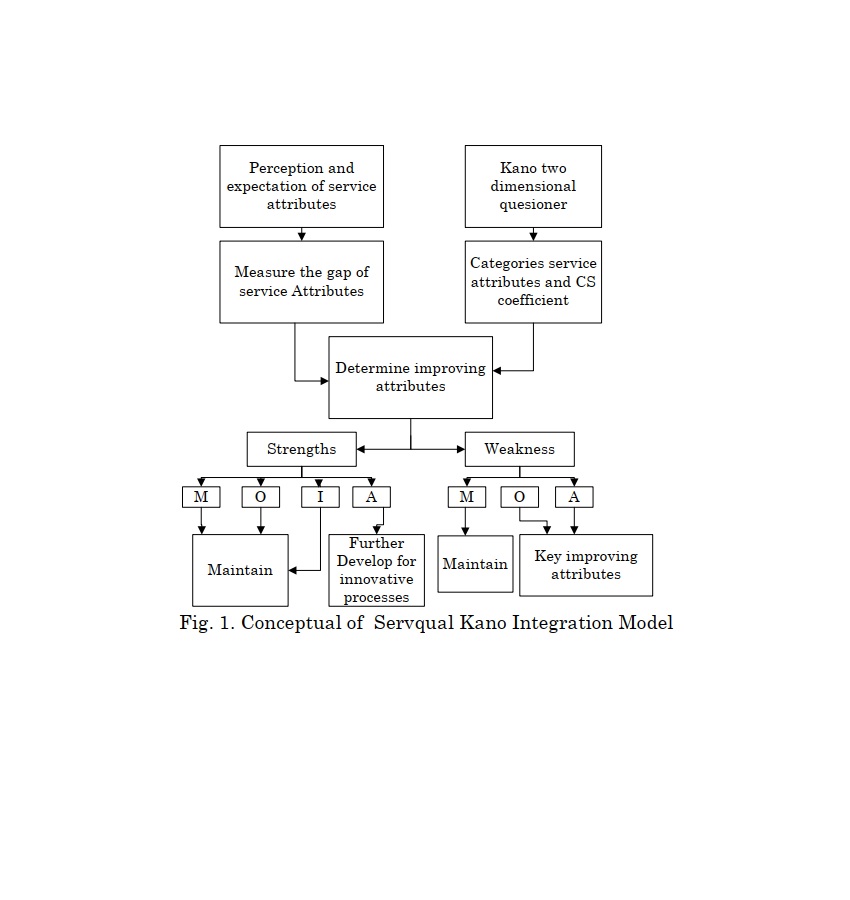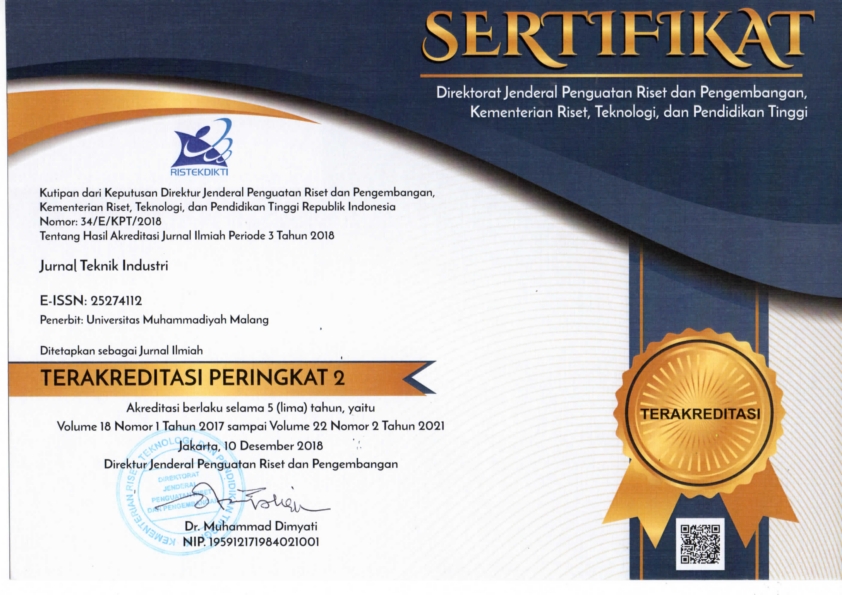Service Quality Assessment using Servqual and Kano Models
DOI:
https://doi.org/10.22219/JTIUMM.Vol20.No1.94-104Keywords:
Service Quality, Servqual, Kano ModelAbstract
This study aims to assess the quality of services by integrating Servqual and the Kano model. In this study, Servqual is used to determine the quality criteria that must be improved. At this method, the quality criteria are based on the gap between customer perceptions and expectations for the services they receive. Meanwhile, the Kano method is used to categorize service attributes that satisfy customer needs. Servqual integration and the Kano model were carried out by synchronizing the Servqual gap value and the Kano model grade. Assessment of service attributes obtained from both methods produces service attributes that will focus on management’s improvement to improve service quality. The results showed that the attribute criteria that must be prioritized were attributes that included attractive and one-dimensional categories, which had weak types at Servqual. Improvements in attributes in attractive and one-dimensional categories will improve service quality and increase customer satisfaction.Downloads
References
[1] A. Gustafsson, M. D. Johnson, and I. Roos, “The effects of customer satisfaction, relationship commitment dimensions, and triggers on customer retention,” Journal of marketing, vol. 69, pp. 210-218, 2005. https://dx.doi.org/10.1509%2Fjmkg.2005.69.4.210.
[2] H. Oh, “Service quality, customer satisfaction, and customer value: A holistic perspective,” International Journal of Hospitality Management, vol. 18, pp. 67-82, 1999. https://dx.doi.org/10.1016/S0278-4319(98)00047-4.
[3] S. A. Taylor and T. L. Baker, “An assessment of the relationship between service quality and customer satisfaction in the formation of consumers’ purchase intentions,” Journal of retailing, vol. 70, pp. 163-178, 1994. https://dx.doi.org/10.1016/0022-4359(94)90013-2.
[4] O. Kitapci, C. Akdogan, and I. T. Dortyol, “The impact of service quality dimensions on patient satisfaction, repurchase intentions and word-of-mouth communication in the public healthcare industry,” Procedia-Social and Behavioral Sciences, vol. 148, pp. 161-169, 2014. https://dx.doi.org/10.1016/j.sbspro.2014.07.030.
[5] E. Cengiz, “Measuring customer satisfaction: must or not,” Journal of Naval Science and Engineering, vol. 6, pp. 76-88, 2010.
[6] A. Parasuraman, V. A. Zeithaml, and L. L. Berry, “Servqual: A multiple-item scale for measuring consumer perc,” Journal of retailing, vol. 64, p. 12, 1988.
[7] R. Ladhari, “A review of twenty years of SERVQUAL research,” International journal of quality and service sciences, vol. 1, pp. 172-198, 2009. https://dx.doi.org/10.1108/17566690910971445.
[8] M. Muhammad Butt and E. Cyril de Run, “Private healthcare quality: applying a SERVQUAL model,” International journal of health care quality assurance, vol. 23, pp. 658-673, 2010. https://dx.doi.org/10.1108/09526861011071580.
[9] H. M. Al-Borie and A. M. Sheikh Damanhouri, “Patients’ satisfaction of service quality in Saudi hospitals: a SERVQUAL analysis,” International journal of health care quality assurance, vol. 26, pp. 20-30, 2013. https://dx.doi.org/10.1108/09526861311288613.
[10] S. S. Lam, “SERVQUAL: A tool for measuring patients’ opinions of hospital service quality in Hong Kong,” Total Quality Management, vol. 8, pp. 145-152, 1997. https://dx.doi.org/10.1080/0954412979587.
[11] R. Ladhari, “Assessment of the psychometric properties of SERVQUAL in the Canadian banking industry,” Journal of Financial Services Marketing, vol. 14, pp. 70-82, 2009. https://dx.doi.org/10.1057/fsm.2009.2.
[12] K. Randheer, A. A. Al-Motawa, and P. J. Vijay, “Measuring commuters’ perception on service quality using SERVQUAL in public transportation,” International Journal of Marketing Studies, vol. 3, p. 21, 2011. https://dx.doi.org/10.5539/ijms.v3n1p21.
[13] Y.-K. Huang, “The Effect of Airline Service Quality on Passengers’ Behavioural Intentions Using SERVQUAL Scores,” Journal of the Eastern Asia Society for Transportation Studies, vol. 8, pp. 2330-2343, 2010. https://dx.doi.org/10.1016/j.jairtraman.2004.06.001.
[14] S. Raspor, “Measuring Perceived Service Quality Using SERVQUAL: A Case Study of the Croatian Hotel Industry,” Management (18544223), vol. 5, 2010.
[15] C. K. Naik, S. B. Gantasala, and G. V. Prabhakar, “Service quality (SERVQUAL) and its effect on customer satisfaction in retailing,” European journal of social sciences, vol. 16, pp. 231-243, 2010.
[16] G. J. Udo, K. K. Bagchi, and P. J. Kirs, “Using SERVQUAL to assess the quality of e-learning experience,” Computers in Human Behavior, vol. 27, pp. 1272-1283, 2011. https://dx.doi.org/10.1016/j.chb.2011.01.009.
[17] S. Zabed Ahmed and Z. Hossain Shoeb, “Measuring service quality of a public university library in Bangladesh using SERVQUAL,” Performance Measurement and Metrics, vol. 10, pp. 17-32, 2009. https://dx.doi.org/10.1108/14678040910949666.
[18] E. Sauerwein, F. Bailom, K. Matzler, and H. H. Hinterhuber, “The Kano model: How to delight your customers,” in International Working Seminar on Production Economics, 1996, pp. 313-327.
[19] A. O. Paraschivescu and A. COTÎRLEŢ, “Kano Model,” Economy Transdisciplinarity Cognition, vol. 15, 2012.
[20] Q. Xu, R. J. Jiao, X. Yang, M. Helander, H. M. Khalid, and A. Opperud, “An analytical Kano model for customer need analysis,” Design studies, vol. 30, pp. 87-110, 2009. https://dx.doi.org/10.1016/j.destud.2008.07.001.
[21] L.-H. Chen and Y.-F. Kuo, “Understanding e-learning service quality of a commercial bank by using Kano’s model,” Total Quality Management & Business Excellence, vol. 22, pp. 99-116, 2011/01/01 2011. https://dx.doi.org/10.1080/14783363.2010.532345.
[22] T. Wang and P. Ji, “Understanding customer needs through quantitative analysis of Kano’s model,” International Journal of Quality & Reliability Management, vol. 27, pp. 173-184, 2010. https://dx.doi.org/10.1108/02656711011014294.
[23] P. Qiting, N. Uno, and Y. Kubota, “Kano Model Analysis of Customer Needs and Satisfaction at the Shanghai Disneyland,” ed, 2011.
[24] B. Clegg, T. Wang, and P. Ji, “Understanding customer needs through quantitative analysis of Kano’s model,” International Journal of Quality & Reliability Management, 2010. https://dx.doi.org/10.1108/02656711011014294.
[25] N.-T. Kuo, K.-C. Chang, and C.-H. Lai, “Identifying critical service quality attributes for higher education in hospitality and tourism: Applications of the Kano model and importance-performance analysis (IPA),” African Journal of Business Management, vol. 5, pp. 12016-12024, 2011. https://dx.doi.org/10.5897/AJBM11.1078.
[26] Y.-F. Kuo, “Integrating Kano’s model into web-community service quality,” Total Quality Management & Business Excellence, vol. 15, pp. 925-939, 2004. https://dx.doi.org/10.1080/14783360410001681854.
[27] T. Materla, E. A. Cudney, and J. Antony, “The application of Kano model in the healthcare industry: a systematic literature review,” Total Quality Management & Business Excellence, vol. 30, pp. 660-681, 2019/04/03 2019. https://dx.doi.org/10.1080/14783363.2017.1328980.
[28] N. WEN, “Guesthouse customer satisfaction analysis using quantitative kano model,” 2015.
[29] J. Mikulić and D. Prebežac, “A critical review of techniques for classifying quality attributes in the Kano model,” Managing Service Quality: An International Journal, vol. 21, pp. 46-66, 2011. https://dx.doi.org/10.1108/09604521111100243.
[30] M. M. Rashid, J. i. Tamaki, A. Ullah, and A. Kubo, “A Kano model based linguistic application for customer needs analysis,” International Journal of Engineering Business Management, vol. 3, pp. 29-36, 2011. https://dx.doi.org/10.5772%2F50934.
[31] K. C. Tan and T. A. Pawitra, “Integrating SERVQUAL and Kano’s model into QFD for service excellence development,” Managing Service Quality: An International Journal, 2001.
[32] H. T. Chen and B. T. Chen, “Integrating Kano model and SIPA grid to identify key service attributes of fast food restaurants,” Journal of Quality Assurance in Hospitality & Tourism, vol. 16, pp. 141-163, 2015. https://dx.doi.org/10.1080/1528008X.2015.1013407.
[33] A. Parasuraman, V. A. Zeithaml, and L. L. Berry, “A conceptual model of service quality and its implications for future research,” Journal of marketing, vol. 49, pp. 41-50, 1985. https://dx.doi.org/10.2307/1251430.
[34] N. Y. Siu and J. T. H. Cheung, “A measure of retail service quality,” Marketing Intelligence & Planning, 2001. https://dx.doi.org/10.1300/J046v16n01_05.
[35] P. A. Dabholkar, D. I. Thorpe, and J. O. Rentz, “A measure of service quality for retail stores: scale development and validation,” Journal of the Academy of marketing Science, vol. 24, p. 3, 1996. https://dx.doi.org/10.1007/BF02893933.
[36] E. F. Yuen and S. S. Chan, “The effect of retail service quality and product quality on customer loyalty,” Journal of Database Marketing & Customer Strategy Management, vol. 17, pp. 222-240, 2010. https://dx.doi.org/10.1057/dbm.2010.13.
[37] N. Bandyopadhyay, “Prioritising retail service quality determinants: a study in the context of India,” International Journal of Business Excellence, vol. 14, pp. 486-498, 2018. https://dx.doi.org/10.1504/IJBEX.2018.090314.
[38] C. Berger, R. Blauth, and D. Boger, “Kanos Methods For Understanding Customer-Defind Quality,” 1993.
[39] S. Bakshi, “Impact of gender on consumer purchase behaviour,” Journal of Research in Commerce and Management, vol. 1, pp. 1-8, 2012.
[40] C. M. Veloso, H. Ribeiro, S. R. Alves, and P. O. Fernandes, “Determinants of Customer Satisfaction and Loyalty in the Traditional Retail Service,” Economic and Social Development: Book of Proceedings, pp. 470-485, 2017.
[41] F.-Y. Pai, T.-M. Yeh, and C.-Y. Tang, “Classifying restaurant service quality attributes by using Kano model and IPA approach,” Total Quality Management & Business Excellence, vol. 29, pp. 301-328, 2018. https://dx.doi.org/10.1080/14783363.2016.1184082.

Downloads
Published
How to Cite
Issue
Section
License
Copyright (c) 2019 Shanty Kusuma Dewi

This work is licensed under a Creative Commons Attribution-ShareAlike 4.0 International License.












